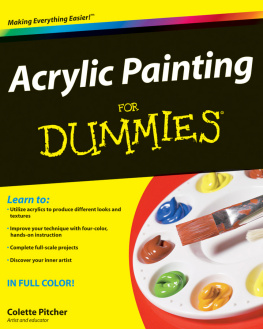Acrylic Painting
The Ultimate Crash Course To Acrylic Painting - Discover the Art of Acrylic Painting for Still Life
Book Description
Acrylic Painting for Beginners is the ultimate guide to acrylic painting. It will introduce the reader to acrylic painting by making them understand what acrylic painting is, why they should go for acrylic painting rather than other forms of painting and even provide them information on why acrylics are loved. The book will introduce a reader looking to start still painting, portrait painting and landscape to the different painting techniques available and how to apply them, how to choose colors, the best brushes and how, how, when and where to use them and eventually give them tips on what to do to become a professional painter. It will highlight the mistakes beginners and pros make and how to eliminate them for a better painting. The topics to be covered in this book include.
Getting to know acrylics
Acrylic painting versus oil paint painting
Acrylic painting techniques
Paint application techniques
Brushes and colors for acrylic painting
Brushes for acrylic painting
Types of acrylic paints
Setting up for painting
Dos, donts and acrylic painting tips
Ten acrylic tips that will make you a better painter
The dos and donts of acrylic painting
Introduction
Have you ever walked into a room and laid eyes on a breathtaking painting?
Gone to an art display or saw a wall hanging and wondered if a certain painting was really done by someone or was computer generated?
Have you ever seen a person standing somewhere only to come closer and realize it is actually a painting?
Or seen a window somewhere showing the outside with birds and the horizon only to look close enough and realize its hand drawn?
Have you ever picked up some paint and brush and tried to bring out such kind of thing only to be disappointed by the end result and the mess created. I am guessing you are not new to all that. If you have had trouble with getting the hang of things this book will help you do it. It is time you discovered acrylic painting.
For a person looking to start painting, acrylic painting is always a great choice. There are so many advantages that make acrylic painting stand out from the other types of painting. It is not only on the characteristics of the paint itself, but also on the results of a painting session. It is easy to use, easy to learn and is never as messy as other paints.
Acrylic paint is great because of its solubility in water, how it dries and its versatility in use. Painters, be it pros or beginners love its flexibility. When something goes wrong as you paint you can always give it a minute or so for it to dry and then paint over the dried area unlike in others where you either have to wash out the entire painting or throw away the canvas. Painters love acrylic paints because they are plastic polymers that can be painted on everything. The only areas you need to stay away from when using this kind of paints is only oily and waxy areas.
Those among other great advantages are complemented by the fact that you dont need hard washing to clear an area of the painting, you just need water and soap. If you are a beginner in Still Life Painting, Landscape Painting and Portrait Painting then acrylic painting is your best bet.
For a long time there has been dependence on watercolor and oil paints for painting, but recent times have seen the emergence and dependence on acrylic paints. The paints have become so popular that painter have even forgotten other types of pains. Advanced painters have had to choose between oil paints and acrylic ones and the acrylics always win. Before we begin is only right that you first of all understand the difference between acrylic paints and oil paints since they seem to be the main two in competition.
Chapter 1 - Getting To Know Acrylics
Acrylics are fast drying paint colors. They are permanent, but very versatile. They were discovered during the 40s and became popular around the 50s and 60s. Since then, their popularity continues to rise due to their adaptability, convenience and economics (Cost and gains).
The paints are water soluble and are made by pigmenting an acrylic polymer (plastic). They are very different from the other two popular paints (Oils and watercolor paints). The paints can be used on canvas, paper (acrylic gesso or not) and any other medium you can think of that can be painted on even those that oil and watercolor cannot be painted on. People use acrylic painting for decorative art, screen printing, airbrushing and painting on fabric.
The paints are highly customizable whereby artists, professionals and beginners only need to add gels and other mediums to further customize the colors. Acrylics will come in all the colors you can think of with different shine ranges including matter, gloss and satin. There are different textures for them ranging from thick impasto to water thick texture. Some are opaque while others are translucent and yes, there are those that are transparent. Some artists have gone to the extent of calling them the revolution of painting because they turned a one hard profession into an easy one.
Acrylic Painting Versus Oil Paint Painting
Paint surface:
A crylic paints can be painted on any surface be it canvas, cards, paper, boards, stone and wood. Unlike oil paints in which you have to choose certain mediums for painting on due to viscosity and absorption issues.
Drying:
C ompared to oil based paints, acrylic paints dry pretty fast and even they dont give the paint time to dry when working, you still need to be fast to ensure the paint doesnt dry off before you are ready.
Flexibility:
O ils dont dry as fast as acrylic and therefore you can be able to work or continue painting tomorrow. The case is different from acrylic. Dries in minutes.
Preparation:
O ils are corrosive and therefore you need to really prepare the canvas before you start working. They have more work than acrylic.
Edges:
W ith acrylic paints , you are able to achieve crisper edges. You will also find with ease that you will be able to create bright, clean colors easily. That is so not the case when it comes to oil paints.
Blending:
S mooth blending for acrylics is pretty hard due to the drying time. When working with a bigger canvas it can be hard to bring a same finish at the same time unless you are a very quick painter. But, you can use retarders and soft gloss to slow the drying. Oils are better for this.
Color lasting:
A crylics take a very long time before the fade. Compared to oil paints, acrylics are way longer lasting. After 200 years they will still look the same due to their light fastness.
Color change:
A crylics color will change as they dry. For instance the white binder in them will dry clearer than it was during application. Layering however, helps prevent color change .
Yellowing:
P aints that are oil based tend to yellow as they dry. This is due to the yellowness in oil. Acrylics may have the colors lighten as they dry, but will never turn yellowish or change.
Next page















